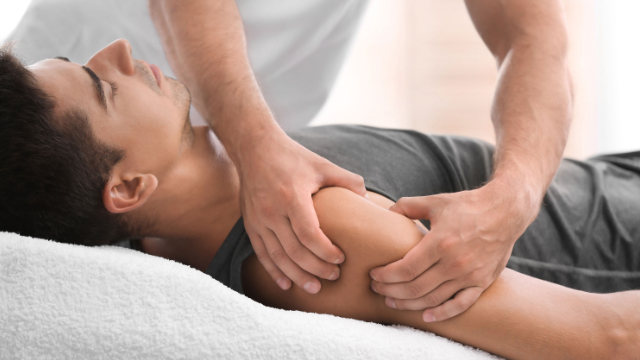
Imagine yourself in the following situation:
You’re on the court, playing in the high school basketball state championship, and having the game of your life. In just over 25 minutes of play, you’ve scored a career high and have been logging a performance for the ages as your team approaches a victory with only minutes to go in the game…when the unthinkable happens. You jump for a rebound and land on the opposing center’s foot, twisting your right ankle inwards and spraining it in the process. Unable to put any pressure on the ankle, you fear the worst as medical staff approaches and tends to your injury. You immediately know that you won’t be able to play again for quite some time, and as you’re assisted off the court, all you can think about is the bright lights in that last instant before the unfortunate landing.
If you can relate to this story in any way, or if you ever encounter a sport injury like this in the future, you’ll know that the next set of questions is almost guaranteed to be the following: “how did this happen and how can I get back on the court or field as quickly as possible?”
While nothing can be done to change the fact that the injury did in fact happen, there is a great deal you can do to improve your chances of returning to your sport in a timely manner. For starters, what you do immediately after a sports injury will have a significant impact on how well and how quickly you recover, which is why you should be prepared for these types of situations with a response plan in place. Failing to completely recover from an injury will increase your chances of additional issues in the future.
The majority of mild injuries can be initially treated with the PRICE protocol
For most mild injuries and certain moderate injuries, the best thing you can do right after the incident is follow the PRICE protocol. Traditionally known as the RICE protocol—for rest, ice, compression, and elevation—the “P” was added more recently and stands for “protection.” Adhering to the principles of PRICE is crucial for alleviating initial symptoms and preventing any further issues from occurring in the first 24-72 hours after injury. Here’s what it should entail:
- Protection: after an acute injury, an athlete should remove themselves from play and protect the injured area from additional damage by applying a bandage, elastic wrap, sling, or splint, or even tape may do the job; if the injury is to any part of the leg, avoid bearing weight on that side and consider using crutches
- Rest: it’s important to take a break from your respective sport in order to allow your body to heal; the amount of rest needed depends on the type and severity of the injury, but if participation leads to pain, it’s wise to continue resting; keep in mind that this doesn’t necessarily mean you need to avoid all activities, but you should avoid those that can further aggravate your injury
- Ice: cold treatment, or cryotherapy, is one of the easiest but most effective ways to reduce pain and other symptoms immediately after an injury; applying ice slows down blood flow to the injured area and in effect reduces inflammation and swelling, as well as muscle spasms; ice should be used as soon as possible after the injury and applied for 15-20 minutes every 1-2 hours for the first few days
- Compression: pressure also helps to reduce inflammation and swelling, while also providing minimal support to the injured area; in most cases a simple elastic bandage will be sufficient, which should be applied snugly but not too tight, and directly to the skin by starting a few inches below the injury and wrapping in a spiral to a few inches above the injured area
- There are also devices available designed specifically for compression that provide an even amount of pressure around an injured area for added benefits; some of these devices combine compression with cold therapy, which temporarily reduces blood flow and allows the cold to penetrate through the skin and deep into the muscles, ligaments, and bones
- Elevation: by elevating the injured body part, you will be draining the pooling of fluids away from that area, which reduces swelling, inflammation and pain; this can be accomplished by positioning the injured area above the level of the heart for as much time as possible for at least the first 48 hours after the injury
Other home remedies to try right after an injury
The PRICE protocol can be supplemented with a number of other remedies that you can usually perform on your own at home, including:
- Heat therapy: applying heat (thermotherapy) increases the flow of blood to the injured area, which in turn stimulates the body’s natural healing mechanisms, while also reducing pain and stiffness; thermotherapy can be applied at similar intervals to cryotherapy (15-20 minutes every 1-2 hours), but should not be used until after the initial inflammation from the injury has begun to die down (usually a few days)
- Contrast therapy: switching back and forth between cryotherapy and thermotherapy alternately opens and constricts the blood vessels and increases blood flow to an injured area without causing additional fluids to accumulate
- Pain medications: acetaminophen (Tylenol) may be best for the first day, as it reduces pain without increasing bleeding; after the first day or two, aspirin or non-steroidal anti-inflammatory drugs (NSAIDs) like ibuprofen (Advil) and naproxen (Aleve) will help to alleviate both inflammation and pain
- Massage: lightly massaging the injured area may help prevent the build-up of fluid that leads to swelling
While these simple remedies are best for mild injuries, more severe injuries require care from a trained professional. In these cases, it’s best to see a physical therapist, who will perform a thorough evaluation of your condition and create a personalized and comprehensive treatment program based on your goals and abilities.









